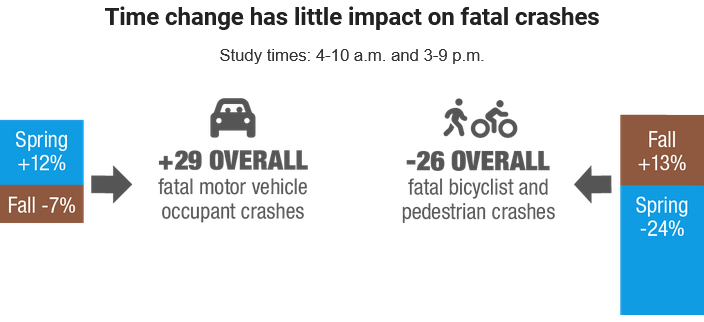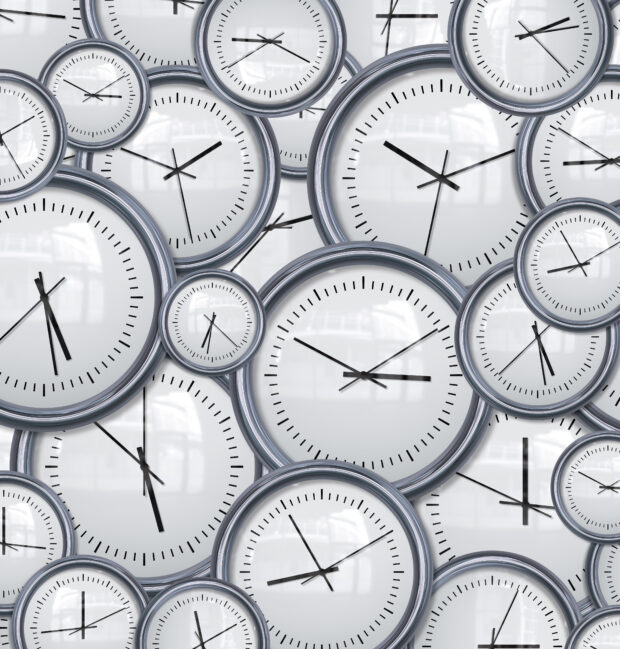A study released earlier this month examining the correlation between daylight savings time and road safety found that “changing the clocks helps pedestrians but hurts motorists.”
Setting clocks forward to better align with daylight hours offers more safety for pedestrians and bicyclists, the Insurance Institute for Highway Safety study revealed.
“These findings won’t end the debate about daylight saving time,” IIHS President David Harkey said. “The benefits for bicyclists and pedestrians are important because that’s where the fatality numbers have increased the most over the past decade. However, they’re largely offset by an increase in crashes in which vehicle occupants were killed.”

To determine the effect of daylight savings time on road safety, IIHS researchers analyzed fatal crash data for the five weeks before and after each time change over 2010-19.
Researchers studied crashes that occurred during the hours when the time change affected the level of light and separated those in which only motor vehicle occupants were killed from those that resulted in bicyclist or pedestrian fatalities.
Examining all crashes that occurred between 4 a.m. and 10 a.m. as well as 3 p.m. and 9 p.m., whether a vehicle occupant, bicyclist or pedestrian was killed, the net effect on fatal crashes was minimal, the researchers found.
In the five weeks after the autumn time change, fatal motor vehicle occupant crashes decreased and fatal bicyclist and pedestrian crashes increased.
Alternatively, in the five weeks after the springtime change, fatal motor vehicle occupant crashes increased and fatal bicyclist and pedestrian crashes decreased.
As a result, the overall effect was 29 more fatal vehicle occupant crashes and 26 fewer fatal pedestrian and cyclist crashes, the data showed.
Effects of the time changes were more pronounced when they looked specifically at the crashes that occurred in the early morning and late afternoon hours when the level of light changed because of the new time.
The entire reduction in fatal bicyclist and pedestrian crashes and virtually none of the increase in fatal vehicle occupant crashes occurred during those periods.
“There are several ways that the time changes could affect crash rates,” said IIHS Research Associate Amber Woods, the lead author of the study. “The disruption in sleep patterns could result in more drowsy driving or more people rushing because they’re running late. However, for bicyclists and pedestrians, the biggest factor appears to be the changing light conditions during key driving periods.”
Most pedestrian crashes occur during daylight hours when most people are walking around, while most pedestrian fatalities happen at night, according to IIHS.
Since 2009, when pedestrian deaths hit an all-time low, they’ve risen 80 percent.
Bicyclist fatalities have risen 75 percent over approximately the same period, the IIHS said.
As a result, bicyclists and pedestrians now account for nearly a fifth of all traffic fatalities, the safety research agency added.
The study findings suggest any gains associated with an extra hour of light on one end of the workday may be tempered by an extra hour of darkness on the other end.
“Although daylight saving time doesn’t seem to be an unequivocal safety win, this study reinforces the importance of visibility for preventing pedestrian and bicyclist crashes,” Harkey said. “Better lighting, especially at crosswalks, improved headlights, and reflective or light-colored clothing can help protect people when the sun goes down — whatever time that may be.”





















 Berkshire Hathaway Announces Leadership Appointments: New CEO at GEICO
Berkshire Hathaway Announces Leadership Appointments: New CEO at GEICO  A Practical Blueprint: The Five Plays of an Innovation Culture
A Practical Blueprint: The Five Plays of an Innovation Culture  Executives on the Move at HSB, American Modern Insurance Group, AIG
Executives on the Move at HSB, American Modern Insurance Group, AIG  Chubb, The Hartford, Liberty and Travelers Team Up on Surety Tech Co. Launch
Chubb, The Hartford, Liberty and Travelers Team Up on Surety Tech Co. Launch 




